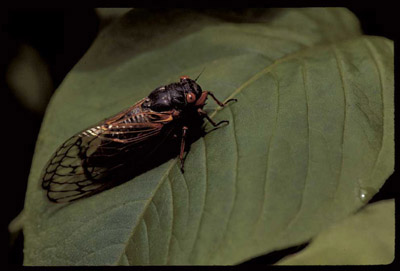

• Intro / Home
• Historical Neighbors
• Street and Backyard
Neighbors
• Park and Green Places
Neighbors
• Shore and Wetlands
Neighbors
• Salt and Freshwater
Neighbors
• Tiny Neighbors
• Unwelcome Neighbors
• Occasional and
Unexpected Neighbors
•
Wildlife Sighting Log
• Resources
• Hours and Tours
• Press Release
• NYPL HOME
| Occasional and Unexpected Neighbors | |
|
Occasional
Intro | Image:1.
2. 3.
4. 5.
|
|
 |
||
|
Periodical Cicada (Magicicada
sp.) |
|
These large (one-and-a-half-inch-long) noisy winged insects are rarely seen, but when they are it is an unforgettable experience. The longest-lived insects, Periodical Cicadas spend most of their lives underground as juveniles or nymphs, for either 13 or 17 years, depending on the species. The entire "brood," or population group, sometimes numbering in the thousands, emerges simultaneously from the earth, crawls up anything vertical, and molts into the insects’ final adult form. Life aboveground is several weeks long at most, during which eggs are laid on the tips of twigs. When thousands of individuals gather, the egg damage can sometimes take a heavy toll on the host tree. The hatchlings drop to the ground, dig in, and spend the next 13 or 17 years 2 feet underground, feeding on root saps. Cicadas do not sting or bite. Locally, Periodical Cicadas occur only on Staten Island. Future emergences of broods are predicted for 2004, 2008, 2013. Check out the sighting
log to record your interaction with some of the native New
York City wildlife, such as the Periodical Cicada, featured in Urban
Neighbors. You may also browse the sighting log by animal, borough,
park or natural area, and/or habitat to view a sighting you have
submitted or to read others’ observations. |